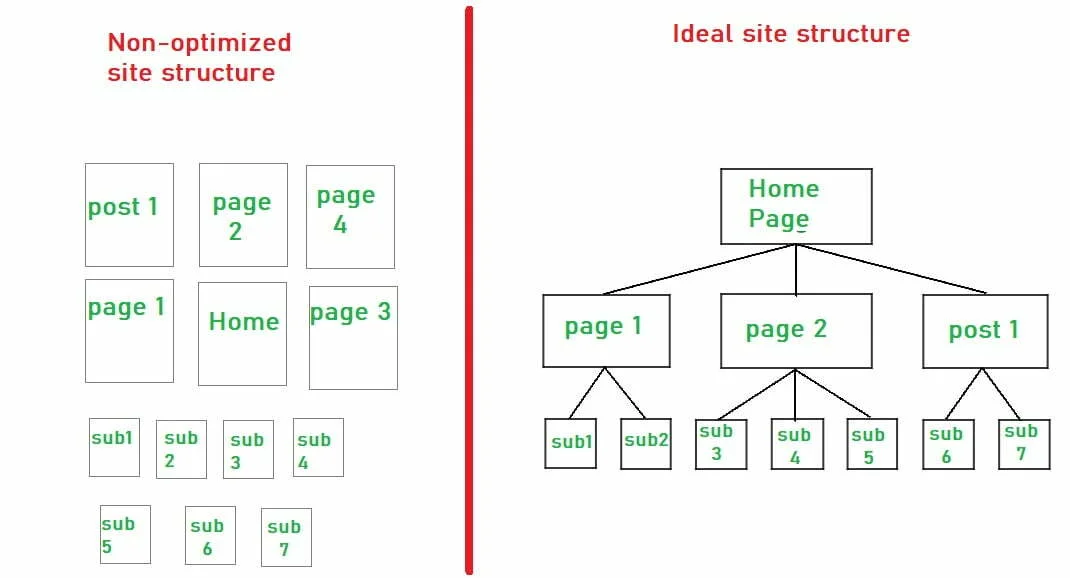What is internal linking in SEO?
Many SEO webmasters seem troubled by the prospect of internal linking within the website. Some may think it is incredibly complex. While others seem to have mastered this SEO technique. Irrespective of the opinion, one fact still remains – internal linking is crucial for SEO.
In simple terms, an internal link connects from one page of the website, to another page of the same website.
There are different types of links
- Menu – These are the top level menu items listed for easy navigation. They are located at the top.
- External links – These are links that connect to external websites
- Internal links – These are links typically present inside the content and add more context to the topic discussed in it. Such contextual links point readers to relevant content in case they need more information.
Today we focus our attention on internal linking.
How do internal links work for Google?
In an internal link, the source domain and target site are the same. The more links a page receives, the more important it is in the eyes of the Google crawler bots. Hence, it is vital to focus on internal linking for Google.
The equation is simple:
1 – a page has to rank in order to boost engagement and improve brand visibility
2 – a page has to be crawlable so that Google bots can reach the target page
Why is internal linking important for SEO?
Here is how the idea works:
1 – The bot comes to the home page and follows the first link. This is a part of its crawling and indexing process
2 – By following the various links, Google tries to establish the site hierarchy
3 – Internal linking allows the Google bot to identify the connection between various pages, posts, and other content.
4 – In addition to knowing the relationship between pages within the site, there is one more thing that happens here. It is Link Value.
Google spreads link equity of a page with all other pages linked on it. Hence, the home page of a site has the highest value. This is because it has links to all the inner pages of the website.
Google crawlers follow links to discover content on the website. When they see many links on the webpage, they consider it a high-value content. As a result, it ranks the page high. Since internal linking is limited to the site itself, the owners can control this aspect of SEO optimization.
What is the purpose of internal linking for SEO?
Google gives a higher ranking to a page with many relevant links, as compared to pages that have lesser links. The reason behind this is how Google algorithms are built. They use powerful NLP techniques to understand one out of ten search queries in English.
But is this enough? Clearly, not enough. Google needs to understand
1 – what the page is about?
2 – how it is connected to other pages on the website
3 – how important is the page in relation to other ones on your site
Is internal linking really helpful?
We see a case study published by Ninja Outreach. This is an eye-opener case study that shows how the company managed to improve organic traffic by a whopping 40% using just internal link optimization. This provides ample evidence on the importance of internal linking for SEO.
Check this snapshot of how organic traffic climbed considerably once they started improving internal links.

It is clear the Google places immense importance on internal linking. It will be a mistake for website owners not to take advantage of this technique.
What are the benefits of internal linking for SEO?
1 – Website structure
Internal links establish the connection of various pages and posts within the site. They help build the categories and sub-categories. They work to group the common pages together. This image shows a good depiction of the ideal site structure grouped in a logical manner.

Imagine if you have two blogs like “Why use Copyscape” and “How to use Grammarly”. Now when we write a blog on “How to ensure content quality”, you can link these two blogs at the relevant places to describe in greater detail the central idea of the blog (How to ensure content quality).
Google will now know there is a connection between the three pages. It will spread link equity between all three pages. As a result, the ranking of these three pages would improve.
2 – Content hierarchy
With internal links, Google comes to know which are the essential pages of your website. Google bots consider pages with many internal links to be more important than other pages that have a lesser number of links.
Now, if you put such pages on your navigation or home page, it gets more link equity. This is because Google understands that as a site owner, you want readers to discover this page.
3 – Improves page view
Since links help the site visitors to traverse from one page to another within the site, it improves the page view. As a result, readers get higher quality information with the help of internal linking. As a site owner, you can improve result core objectives like engagement and conversion.
4 – Improves engagement
Site visitors get information and education through content. With internal linking, the quality and depth of information provided goes up dramatically. Hence it is best to use logical and sensible internal linking. This technique enhances user retention and gives them a reason to stay on your website.
What are the best practices for internal linking for SEO?
Now that we know the basics of internal linking, let us go a step ahead. Let us see how we can apply tactics to improve the optimization potential of internal linking.
1 – Create lots of quality content
If your site has just one page, then you can (suppose) add just 2-3 links. But if your site has 20 pages, then you can add 3 x 20 = 60 quality links. So the first internal inking practice will be to create lots of content. Place meaningful links to other webpages of your site.
2 – Use anchor text
In the above example, we see that the three words “Check for typos” are hyperlinked to this link. These three words then become the anchor text for this link. You may have the option of linking an image in place of these three words of text.
But SEO best practices say that it is better to use anchor text. There is no optimization to be done here. You need to place anchor text organically within the sentence or paragraph. No fancy stuff needed here.
3 – Optimize the inner pages
You have some pages that come up on the main website menu. These are top level pages like home. You need to shift your attention from such pages and move to inner pages. In the above example of the three blog posts, all three are inner pages. None of the three appears in the website’s main menu.
4 – Keep the reader in mind
Think from a reader’s perspective if you are wondering where to link to. The objective here is, first and foremost, your reader needs to get in-depth information. The link should provide value and information to the readers.
Remember the above example of a blog post “How to improve content quality”?
1 – key topic is “How to improve content quality”
2 – One subheading within it is “Check for plagiarism. In it you will have an anchor text “Use Copyscape”. This will link to an earlier post you must have written on the topic “Why use Copyscape”
3 – Another subheading within it is “Check for typos”. This will link to another post “How to use Grammarly” with the anchor text as “Use Grammarly”
Google will spread the link equity between the three posts. But to re-iterate, link equity is secondary, providing value to readers is the primary goal here.
As a site owner, you remember that you had written on certain broad themes around quality in the past. You can retrieve those blog posts and add their links at logical places.
5 – Focus on the relevance of the links
If your site has 25 pages, does this mean that you can put any link on a page?
No. It has to be a well-thought out decision about which link to use where, inside a webpage’s content. The key theme here is relevance.
Suppose if the reader is on a blog for “Advantages of PPC” the natural CTA link will be to the PPC service page at the end of the blog. it will be unwise to add a link like “About us” in this.
We need to understand reader psychology here. The reader has reached the anchor text (the CTA at the end of the blog). What do you want her to do now? Of course, she can go and check the company’s PPC services. If she likes what she sees, then she will click on the ‘Send an enquiry’ button inside the service page.
This journey from the blog to PPC service page to contact us form is enabled with quality and relevant links.
To sign off
Internal linking for SEO is considered one of the most powerful content marketing activities. Since this is totally under the website owner’s control, there is added impetus to pay attention to it. It is often considered one of the simplest ways to see an SEO uptick. Internal linking in blogs can ensure considerable SEO gains.
In case you require professional support to meet this goal then connect with Textuar. You can hire our web content writers to understand your website well and can link to relevant content within your blogs.











